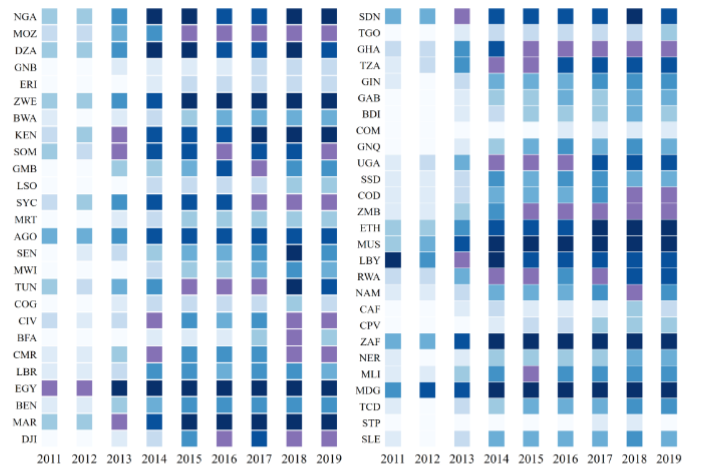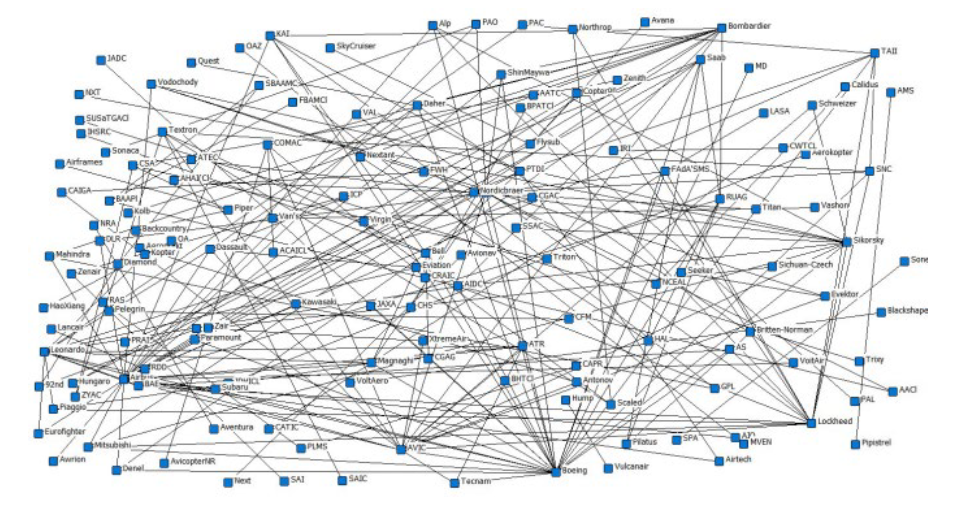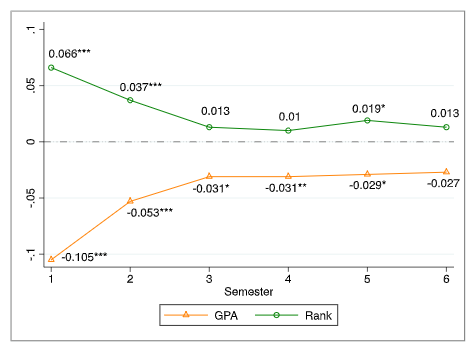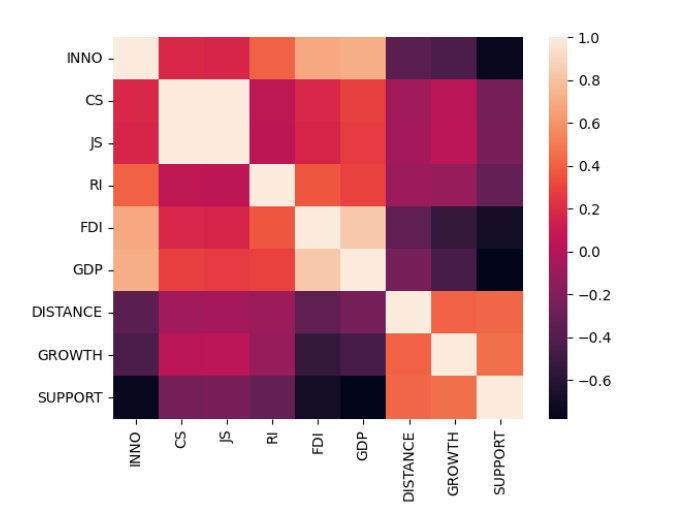Follow Suit: Imitative governance, resource inclination, and regional innovation efficiency
Abstract
Influenced by traditional notions of solidarity, when a province’s planning can be highly aligned with that of the central government, the province is perceived to be more collective and thus able to receive financial or resource favors from the central government. This consistency, as is often the case, reflected in doing the same thing as the central government. This situation may lead governors to ignore local economic performance and thus reduce regional innovation efficiency, as in the case of China’s Great Leap Forward. Likewise, it is possible to get better resources (energy or capital) by demonstrating managerial submissiveness, thus improving the regional innovation efficiency. Therefore, to verify the relationship between imitative governance and regional innovation efficiency, we collected relevant data from 31 major provincial administrative units in China, calculated the degree of imitative governance between provincial government work reports and central government work reports through text similarity, as well as utilized the SBM-DEA model to evaluate regional innovation efficiency. Meanwhile, we provide a new explanation of the phenomenon from the perspective of resource inclination. Finally, the empirical results show that imitative governance promotes local innovation efficiency and is moderated by resource inclination.
Cite This Paper
Zor, S., Chen, J., Ailimujiang, J., & Wang, F. (2023). Follow Suit: Imitative governance, resource inclination, and regional innovation efficiency. Review of Economic Assessment, 2(1), 7. doi:10.58567/rea02010002
Zor, S.; Chen, J.; Ailimujiang, J.; Wang, F. Follow Suit: Imitative governance, resource inclination, and regional innovation efficiency. Review of Economic Assessment, 2023, 2, 7. doi:10.58567/rea02010002
Zor S, Chen J, Ailimujiang J et al.. Follow Suit: Imitative governance, resource inclination, and regional innovation efficiency. Review of Economic Assessment; 2023, 2(1):7. doi:10.58567/rea02010002
Zor, Shutter; Chen, Jingru; Ailimujiang, Jietie; Wang, Fayao 2023. "Follow Suit: Imitative governance, resource inclination, and regional innovation efficiency" Review of Economic Assessment 2, no.1:7. doi:10.58567/rea02010002
Show Figures
Share and Cite
Article Metrics
References
- Ataay, A. (2020). CEO outsiderness and firm performance in an emerging economy: The moderating role of managerial discretion. J. Manag. Organ. 26(5), 798-814. https://doi.org/10.1017/jmo.2018.36
- Barney, J.B., Ketchen, D.J., Wright, M. (2011). The Future of Resource-Based Theory: Revitalization or Decline? J. Manag. 37(5), 1299-1315. https://doi.org/10.1177/0149206310391805
- Bel, R., Smirnov, V., Wait, A. (2018). Managing change: Communication, managerial style and change in organizations. Econ. Model. 69, 1-12. https://doi.org/10.1016/j.econmod.2017.09.001
- Chang, Y.T., Zhang, N., Danao, D., Zhang, N. (2013). Environmental efficiency analysis of transportation system in China: A non-radial DEA approach. Energy Policy 58, 277-283. https://doi.org/10.1016/j.enpol.2013.03.011
- Charnes, A., Cooper, W.W., Rhodes, E. (1978). Measuring the efficiency of decision making units. European Journal of Operational Research 2(6), 429-444. https://doi.org/https://doi.org/10.1016/0377-2217(78)90138-8
- Chen, F., Ding, J., Li, M., & Wang, B. (2021). From self‐entertainment to being appreciated: how does social media transfer talent to business?. Accounting & Finance, 61(5), 6113-6146. https://doi.org/10.1111/acfi.12859
- Chen, K.H., Kou, M.T., Fu, X.L. (2018). Evaluation of multi-period regional R&D efficiency: An application of dynamic DEA to China's regional R&D systems. Omega-Int. J. Manage. Sci. 74, 103-114. https://doi.org/10.1016/j.omega.2017.01.010
- Chen, T.J., Chen, H.M., Ku, Y.H. (2012). Resource dependency and parent-subsidiary capability transfers. J. World Bus. 47(2), 259-266. https://doi.org/10.1016/j.jwb.2011.04.013
- Cohen, L., Malloy, C., Nguyen, Q. (2020). Lazy Prices. J. Financ. 75(3), 1371-1415. https://doi.org/10.1111/jofi.12885
- Cong, D., Liang, L.L., Jing, S.X., Han, Y.M., Geng, Z.Q., Chu, C. (2021). Energy supply efficiency evaluation of integrated energy systems using novel SBM-DEA integrating Monte Carlo. Energy 231, 10. https://doi.org/10.1016/j.energy.2021.120834
- Deng, G.Y., Li, L., Song, Y.N. (2016). Provincial water use efficiency measurement and factor analysis in China: Based on SBM-DEA model. Ecol. Indic. 69, 12-18. https://doi.org/10.1016/j.ecolind.2016.03.052
- Ding, J., Liu, B., & Shao, X. (2022). Spatial effects of industrial synergistic agglomeration and regional green development efficiency: Evidence from China. Energy Economics, 112, 106156. https://doi.org/10.1016/j.eneco.2022.106156
- Du, K.R., Cheng, Y.Y., Yao, X. (2021). Environmental regulation, green technology innovation, and industrial structure upgrading: The road to the green transformation of Chinese cities. Energy Econ. 98, 10. https://doi.org/10.1016/j.eneco.2021.105247
- Giachetti, C., Li Pira, S. (2022). Catching up with the market leader: Does it pay to rapidly imitate its innovations? Res. Policy 51(5), 14. https://doi.org/10.1016/j.respol.2022.104505
- Gore, L.L.P. (2019). The Communist Party-Dominated Governance Model of China: Legitimacy, Accountability, and Meritocracy. Polity 51(1), 161-194. https://doi.org/10.1086/700615
- Hu, J. (2023). Synergistic effect of pollution reduction and carbon emission mitigation in the digital economy. Journal of Environmental Management, 337, 117755. https://doi.org/10.1016/j.jenvman.2023.117755
- Hu, J., Zhang, H., & Irfan, M. (2023). How does digital infrastructure construction affect low-carbon development? A multidimensional interpretation of evidence from China. Journal of Cleaner Production, 396, 136467. https://doi.org/10.1016/j.jclepro.2023.136467
- Ji, Y.H., Lei, Y.L., Li, L., Zhang, A., Wu, S.M., Li, Q. (2021). Evaluation of the implementation effects and the influencing factors of resource tax in China. Resour. Policy 72, 9. https://doi.org/10.1016/j.resourpol.2021.102126
- Kim, D.H., Wu, Y.C., Lin, S.C. (2018). Heterogeneity in the effects of government size and governance on economic growth. Econ. Model. 68, 205-216. https://doi.org/10.1016/j.econmod.2017.07.014
- Kozlenkova, I.V., Samaha, S.A., Palmatier, R.W. (2014). Resource-based theory in marketing. J. Acad. Mark. Sci. 42(1), 1-21. https://doi.org/10.1007/s11747-013-0336-7
- Li, Z., Li, Y.B., Shao, S.S. (2019). Analysis of Influencing Factors and Trend Forecast of Carbon Emission from Energy Consumption in China Based on Expanded STIRPAT Model. Energies 12(16), 14. https://doi.org/10.3390/en12163054
- Lin, X.Y., Zhu, X.P., Han, Y.M., Geng, Z.Q., Liu, L. (2020). Economy and carbon dioxide emissions effects of energy structures in the world: Evidence based on SBM-DEA model. Sci. Total Environ. 729, 9. https://doi.org/10.1016/j.scitotenv.2020.138947
- Liu, B., Ju, T., Bai, M., Yu, C.F. (2021). Imitative innovation and financial distress risk: The moderating role of executive foreign experience. Int. Rev. Econ. Financ. 71, 526-548. https://doi.org/10.1016/j.iref.2020.09.021
- Maiti, M., Krakovich, V., Shams, S.M.R., Vukovic, D.B. (2020). Resource-based model for small innovative enterprises. Manag. Decis. 58(8), 1525-1541. https://doi.org/10.1108/md-06-2019-0725
- Marquis, C., Qiao, K.Y. (2020). Waking from Mao's Dream: Communist Ideological Imprinting and the Internationalization of Entrepreneurial Ventures in China. Adm. Sci. Q. 65(3), 795-830. https://doi.org/10.1177/0001839218792837
- Mol, M.J., Kotabe, M. (2011). Overcoming Inertia: Drivers of the Outsourcing Process. Long Range Plan. 44(3), 160-178. https://doi.org/10.1016/j.lrp.2010.12.002
- Ouyang, X.L., Li, Q., Du, K.R. (2020). How does environmental regulation promote technological innovations in the industrial sector? Evidence from Chinese provincial panel data. Energy Policy 139, 10. https://doi.org/10.1016/j.enpol.2020.111310
- Ployhart, R.E. (2021). Resources for What? Understanding Performance in the Resource-Based View and Strategic Human Capital Resource Literatures. J. Manag. 47(7), 1771-1786. https://doi.org/10.1177/01492063211003137
- Shen, W.T., Yang, C., Huang, B.Y. (2022). Impact of Managerial Discretion "Stranglehold" on Enterprises Investment Efficiency: Based on Heterogeneous Stochastic Frontier Model. Emerg. Mark. Financ. Trade 58(13), 3711-3725. https://doi.org/10.1080/1540496x.2022.2068410
- Shi, J.M., Katehakis, M.N., Melamed, B. (2013). Martingale methods for pricing inventory penalties under continuous replenishment and compound renewal demands. Ann. Oper. Res. 208(1), 593-612. https://doi.org/10.1007/s10479-012-1130-5
- Shih, V., Adolph, C., Liu, M.X. (2012). Getting Ahead in the Communist Party: Explaining the Advancement of Central Committee Members in China. Am. Polit. Sci. Rev. 106(1), 166-187. https://doi.org/10.1017/s0003055411000566
- Shuai, S., Fan, Z. (2020). Modeling the role of environmental regulations in regional green economy efficiency of China: Empirical evidence from super efficiency DEA-Tobit model. J. Environ. Manage. 261, 8. https://doi.org/10.1016/j.jenvman.2020.110227
- Wang, D.P., Du, K.R., Zhang, N. (2022). Measuring technical efficiency and total factor productivity change with undesirable outputs in Stata. Stata J. 22(1), 103-124. https://doi.org/10.1177/1536867x221083886
- Wang, J.X., Lin, J.T., Feng, K.S., Liu, P., Du, M.X., Ni, R.J., Chen, L.L., Kong, H., Weng, H.J., Liu, M.Y., Baiocchi, G., Zhao, Y., Mi, Z.F., Cao, J., Hubacek, K. (2019). Environmental taxation and regional inequality in China. Sci. Bull. 64(22), 1691-1699. https://doi.org/10.1016/j.scib.2019.09.017
- Wang, L. (2023). Political cycle and effective corporate tax rate: evidence from China. Applied Economics, 1-14. https://doi.org/10.1080/00036846.2023.2174937
- Wu, J.D., Li, N., Shi, P.J. (2014). Benchmark wealth capital stock estimations across China's 344 prefectures: 1978 to 2012. China Econ. Rev. 31, 288-302. https://doi.org/10.1016/j.chieco.2014.10.008
- Zhang, J., Du, Z.L., Fu, L.Q., Han, Y.M., Zheng, W., Yu, F.H., Chen, H.M., Feng, L., Li, Y.Q., Ping, W.Y. (2021). Novel anaerobic digestion and carbon dioxide emissions efficiency analysis of food waste treatment based on SBM-DEA model. J. Clean Prod. 328, 11. https://doi.org/10.1016/j.jclepro.2021.129591
- Zor, S. (2023). Conservation or revolution? The sustainable transition of textile and apparel firms under the environmental regulation: Evidence from China. Journal of Cleaner Production, 382, 135339. https://doi.org/10.1016/j.jclepro.2022.135339



